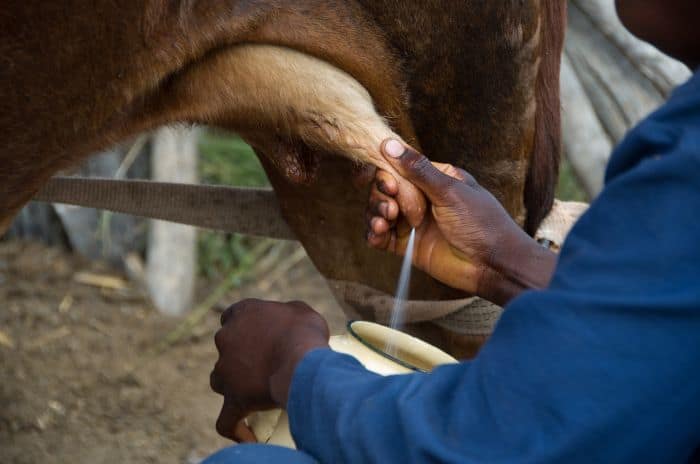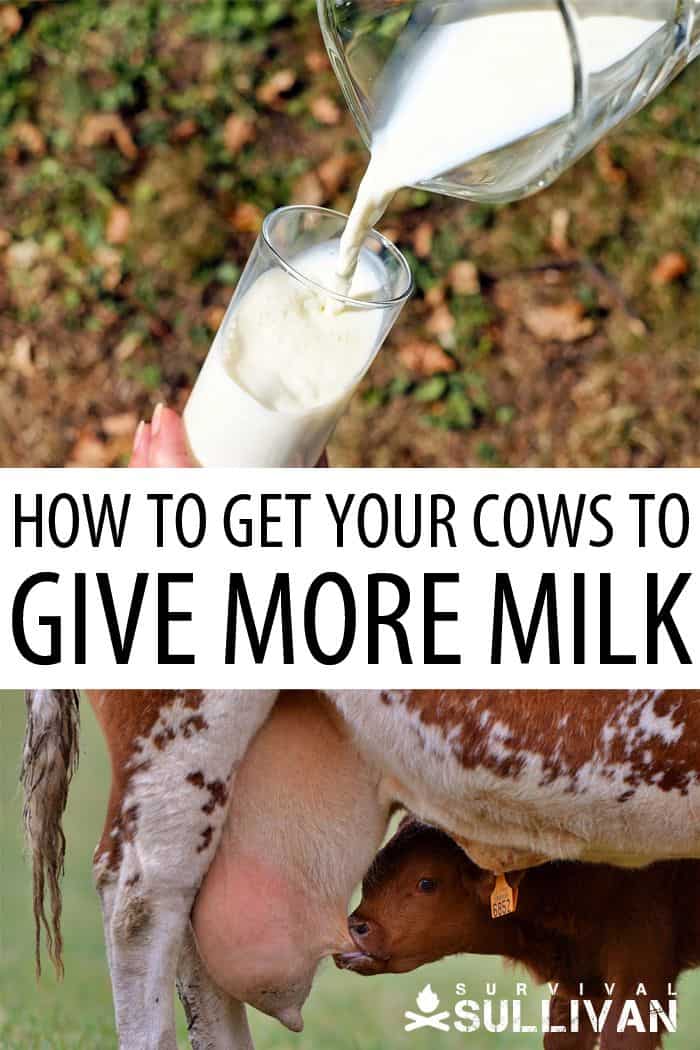Keeping cattle for the purpose of milk production is an excellent idea for a number of reasons. You end up consuming better quality milk for a fraction of the cost.
It’s not particularly hard to keep a cow, you just need to pay attention to detail, and plan ahead. However, sometimes despite all your best efforts your cow is simply not producing enough milk. Boosting milk production is a matter of balance and technique.

If you have already decided to keep a cow for the production of milk, it is likely that you have already taken into account all the environmental factors that are at play when keeping livestock so we will not be talking about the very basics of keeping a cow producing milk.
The ways in which you can do this depend quite a bit on your area and on the season, it is far more complicated to boost milk production during winter than during spring so what follows is a breakdown of the basics and then special tips for those dreaded winter months.
Feeding
This almost seems like a superfluous point, mainly because everyone knows that you need to feed your animals if you want them to produce anything at all.
The reason it is first on this list is that keeping cattle for milk production is not just feeding them, it is about what you feed them, how you feed them and how both of these factors affect the way in which your cattle produces milk and in what amount they do.
Proper management is essential and the most important thing about management is the feeding part of it. The amount and the quality of milk produced is directly affected, not only by what the animal is fed, but also under which conditions it is fed.
This means that you should definitely consider investing in a proper shed and its cleanliness because what you save in building a cheap shed, you will end up spending on veterinary expenses.
This is what you need to know about feeding your cows to improve milk yield.
1. Nutrition and Feed Requirements
The feeding that lactating cows require is quite different from that of heifers and calves. For starters, the amount of feed will depend on the amount of milk it produces along with its weight, temperature, and the level of activity it is subjected to.
The cow will need a balanced feed that has enough carbohydrates and fats to provide energy, as well as protein, fiber, water, vitamins, and minerals.
Along with this you will need to make sure that the feed can be digested properly so that the greatest number of nutrients are absorbed into the body, thereby ensuring that your money will not go to waste.
These nutritional and feed requirements also include providing enough water, this means that you should have a very reliable water source. An average dairy cow will need around 60 liters of water per day, providing less will rapidly decrease milk production.
Make Sure that Fodder Has Enough Dry Matter
Napier grass is widely considered to be the most important feed for dairy cattle since it encourages milk production, weight gain and growth; however, Napier grass is made up of 70 to 80 percent water which means that the cows will only get 20 to 30 percent of dry matter.
This is not ideal for digestion and will do nothing to improve the levels of milk fat. You should make sure to include roughage as well as other energy sources (maize, molasses, and wheat germ). A cow that weighs 400 kg (881 lbs) will need 10 to 15 kg (22 to 33 lbs) of fodder per day.
Energy Needs
Meeting the cow’s energy needs means providing enough fodder to fill its stomach, a cow requires a basal diet that cannot be substituted by supplementary feeds (such as concentrates).
Milk production will never increase if the cow is not given sufficient fodder since it will have to use the feed to maintain its body, this means that only the very basic requirements are being met and so, the animal will only be able to produce a sufficient amount of milk.
To boost milk production, you will need to increase the amount of energy that the cow has available.
Protein
Protein is only second to fodder in importance in dietary terms. In dairy cows, the protein will help maintain its body (which will keep milk production up) and also will help the microorganisms in the stomach to convert roughage into nutrients.
Cutting back on the amount of protein in the feed will result in smaller animals that mature later, low weight and very reduced milk production.
Legumes such as white clover, sweet potato vine, and bean straw are excellent protein sources and so is calliandra, and leucaena (fodder trees). Including these in your cow’s diet will save you money without affecting milk production, since 3kg of tree fodder and legumes will allow for the same milk yield as 1kg (2 lbs 3 oz.) of dairy meal.
This means that you can feed the cow 12kg (26 lbs 7 oz.) of legumes instead of 4kg (8 lbs 13 oz.) of dairy meal and not lose in terms of milk yield.
Vitamins and Minerals
The addition of vitamins and minerals is important for all cows, but especially for pregnant ones since it encourages proper tissue development of the calf. Mineral licks, natural or otherwise, are the best way to provide the cow with the minerals they need, you should never give them table salt.
Cows are incapable of producing vitamins A, D or E so they should be supplied in the diet, otherwise the quality and yield of the milk produced will decrease significantly. Adding vitamins will definitely boost the quality of the milk produced.
2. Ensure an Appropriately Long Dry Period
It is impossible to keep a cow producing milk all the time, in fact it is unhealthy and bad for milk production. The mammary gland of a dairy cow requires a non-lactating period before giving birth in order to optimize milk production, this period is called a dry period in which fresh udder tissue is formed ahead of lactation.
Not only is the dry period important to secure high milk yields, it is also the perfect time to rid the udder of pathogens which are harmful to both the cow’s health and the quality of milk produced.
To successfully dry off a cow, you will have to withdraw grain and reduce the water supply several days ahead of the start of the dry period, during that time the production of milk will be greatly reduced.
You should halt milking 45 to 50 days before the delivery of the calf. Consider infusing the udder with antibiotics to prevent infections.
The optimal duration of the dry period is, as we mentioned 45 to 50 days before calving, reducing the length of the dry period will decrease milk production up to 38%; however, a long dry period will also result in reduced milk yield.
To boost milk production, ensure a successful dry period. If you are keeping several cows, you can alternate the dry period in order to ensure year-round milk production.
3. Optimize Comfort
It sounds odd but making sure that your cow is comfortable will boost milk production. There are two reasons behind this point: the first is that a stressed cow will not produce as much milk as a comfortable cow, the second is that cows need to be able to lie down comfortably at least 12 times a day.
Here are the two simplest ways to boost milk production by optimizing comfort.
Control the Temperature
This also happens to be a winter tip. Lower temperatures will cause your cow to become stressed very quickly, and just as you cannot really get anything done when you are stressed, your cow will not be able to produce enough milk.
This happens because the cows have a type of defense mechanism that decreases milk production if it senses danger in order to keep nutrients and energy to ensure its survival (as danger means less food).
Cows Need a Lie-down from Time to Time
A healthy cow will lie down 12 to 15 times a day and this is good news for milk production since circulation is 25 to 30 percent faster when the cow is lying down and for a cow to produce 1 liter (2.11 pts.) of milk it needs around 400 liters (105 gal.) of blood to pass through its udder.
Providing a comfortable environment in which the cow is able to lie down will therefore increase the production of milk significantly.
4. Reduce Inflammation After Birth
Research has shown that inflammation of the udder decreases milk production. The reason behind this is quite simple, inflammation means pressure on the mammary glands which leads the cow’s body to believe that the pressure is coming from an excess of milk so it decreases the production or halts it altogether.
Inflammation following calving has a negative effect on milk production that will last at the very least four weeks.
While inflammation is a natural bodily response, there is such a thing as too much, giving your cows a non-steroidal anti-inflammatory drug is the best way to combat this which is not ideal for a TSHTF scenario; however, inflammation can be reduced with Aloe Vera to similar results.
5. Partially Wean the Calf and Milk Twice a Day
There are many discussions regarding when you should wean the calf and how often you should be milking your cow, it is not a matter of personal preference, there is a best and worst way to do it.
Some people will recommend that you wean the calf completely so that all of the cow’s milk is available for consumption, this might seem like a tempting idea; however, there is higher risk and higher cost to doing things this way.
For a complete weaning, you will need to remove the calf after a couple of days and pen it somewhere where the cow and calf cannot see each other or even hear each other.
Unless you want your calf to die or be undernourished (thereby halving the calf’s future milk production) you will have to bottle feed the calf using milk replacers, which will most likely need to be imported (very bad news for a SHTF situation).
To ensure the maximum amount of milk for yourself as well as the health of the calf, the best thing to do is to partially wean it. This means that the cow and calf are kept separate (so that the calf cannot suckle the cow whenever it wants) but close enough that they see each other.
The calf should be given feed and water and only be allowed to suckle on the cow after the morning and evening milking have concluded.
Keeping the calf around the cow for longer has shown to increase milk production as well as the amount of time that the cow produces milk for.
6. Be Extra Careful With Them During Winters
Everything changes during the winter and this directly affects milk production. Because of the cold, the feed will not be the same, the amount of water available will change and the cows are likely to get stressed. In order to avoid the worst of this you will have to take special care with your cows.
The first thing is to make sure that your cows are ready for winter. Because of the cold, it is unlikely that you will be able to provide the appropriate feed in the appropriate amounts, this means that, unless you want the milk production to drop dramatically, you will have to make sure that your cows are heavy enough for the winter.
If they are too thin they will have to use their fat stores to keep warm and will be unable to give you milk; however, the same is true for an obese cow, so you will have to make sure that they are the appropriate weight.
The second important thing is that your cows will have to acclimate to the cold so that they are able to grow their winter coat.
If you keep them too shielded, then the will have no reason to grow a winter coat so unless you are absolutely sure that you can provide a temperature-stable environment –which would be practically impossible, or at the very least, inefficient in a post-SHTF scenario– you will want to take your cows outside to acclimate slowly to the cold.
Third, you will have to feed them more, this will contribute to both temperature and weight. Because of the cold, the cows will need more energy just to keep warm which means that if you keep their diet the same as you would during warm weather, they will soon be burning through their reserve stock to keep warm.
If you followed the first two steps, then you will be able to keep your cows on regular rations until they reach critical temperature (around 20-30°F) after that you will have to increase rations by 1 percent for every 2°F below critical temperature.
And last but not least, keep her teats healthy and protected. Teats are quite delicate, just like your lips in cold weather, they are likely to chap, swell, and be sore. Making sure that their teats are healthy will reduce the chance on inflammation and infection.
Remember that teats are also extremities and they can freeze so keep them dry and protected from wind to avoid this. A cow with sore teats will be unable to give you the same amount of milk as a cow with healthy teats.
Wrap-Up
You have already made an excellent choice by choosing to keep cattle for milk production and by following these guidelines and tips, you will ensure that your money will not be wasted and you will be fully prepared to face TEOTWAWKI.


My name is Teresa Fikes. I am a Homesteader, survivalist, prepper, historian, and writer plus much more all in one package deal. I was raised on a small family farm were I was taught at an early age to survive off the land without the help of modern conveniences. I am a writer by profession and a Homesteader by Blood, Sweat, and Tears.

Thank you for this article! With the calf sharing, what feed is recommended to leave with a young baby (a couple weeks +) during the time away from mama? Also, what age is best to start this split time vs 24 hr access? Thank you!